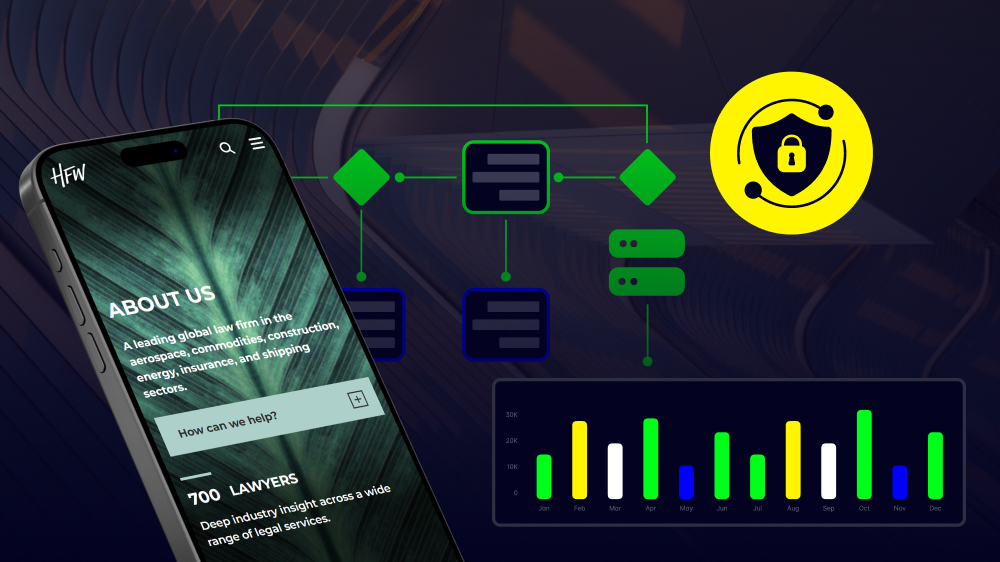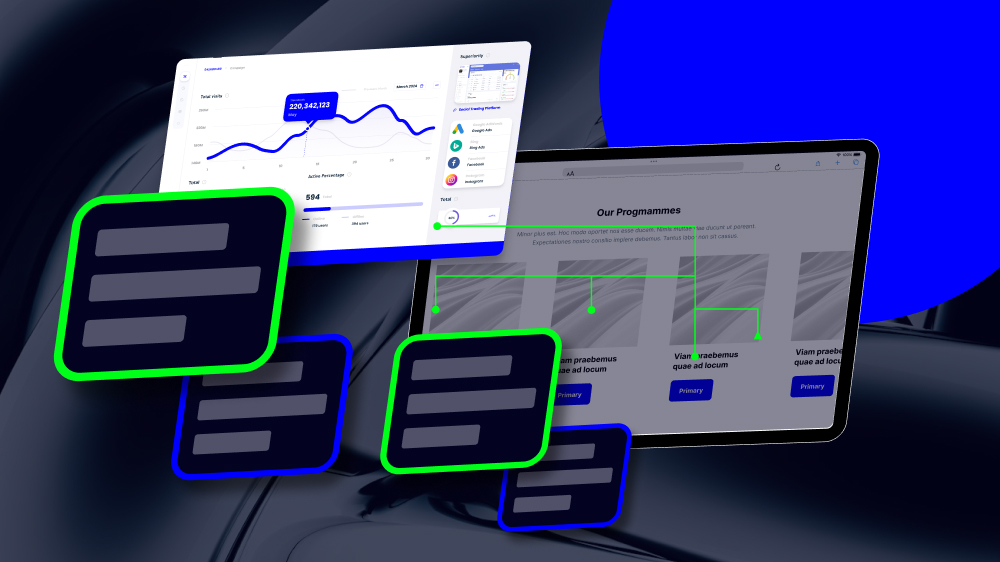Enterprise Website Maintenance: Checklist and Why it’s Necessary
Just like you take your car for a regular service to keep it running smoothly, your website also needs systematic attention to perform at its best.
Website maintenance is essential to getting maximum long-term value out of your most important digital investment. Instead of requiring full website redesigns every few years, careful monthly maintenance keeps your website up-to-date and performing at the highest level.
From SEO performance to user experience considerations, consistent updates and maintenance keep all areas of your digital presence running at the best of their abilities.
Follow this guide to understand exactly what areas of enterprise website maintenance are necessary and what you should be doing to maintain your website.

Harry Hammett is a detail-driven Project Co-Ordinator at Itineris, ensuring seamless delivery across digital projects. With a keen eye for organisation and efficiency, he keeps teams aligned and clients informed, driving success through clear communication and meticulous planning.
Synopsis
- Enterprise website maintenance is a business-critical function: it ensures technical resilience, data protection, compliance, and consistent user experience, preventing reputational and financial risks.
- Regular, structured upkeep reduces long-term costs: by controlling technical debt, maintaining performance, and avoiding expensive full rebuilds, maintenance extends the lifespan and value of enterprise websites.
- A disciplined checklist approach is essential: covering updates, backups, SEO and accessibility audits, content governance, and performance monitoring to keep complex enterprise platforms secure, compliant, and optimised.
Table of Contents
What is Enterprise Website Maintenance?
Website maintenance is the ongoing process of ensuring your website remains functional, secure, fast, and aligned with business objectives.
For enterprise organisations, this goes deep into technical aspects of large websites. It encompasses structured processes for performance monitoring, security patching, accessibility compliance, SEO upkeep, content governance, and disaster recovery planning.
At scale, even minor failures can have a disproportionate impact. A single broken script or downtime event can erode customer trust, disrupt lead generation, or create vulnerabilities in data protection workflows.
Importantly, enterprise website maintenance is not a one-off task, but a foundational operational requirement for any organisation with a strong digital presence.
What are Website Maintenance Services?
Website maintenance services are a structured set of ongoing activities designed to keep enterprise websites secure, operational, and optimised for performance.
These services typically include uptime monitoring, vulnerability patching, SEO and analytics health checks, content governance, codebase maintenance, and platform updates.
Delivered either in-house or via a specialised agency, they help large organisations manage the complexity of multi-team workflows, compliance requirements, and high user expectations across global digital estates.
Why Enterprise Website Maintenance is Essential
For any enterprise organisation, their website is their most valuable digital asset.
Enterprise websites play a critical role in supporting brand visibility, customer engagement, lead generation, and core business operations. With that level of responsibility, maintenance is essential for:
- Maintaining technical resilience
- Protecting data
- Maintaining business operations
- Ensuring a consistent, high-quality user experience
Neglecting an enterprise website covers major reputational, operational, and financial risks.
Below, we break down the key security and performance considerations that make website maintenance a business-critical function.
Security
Enterprise websites are prime targets for malicious attacks, especially when they’re built on popular CMS platforms with large codebases and third-party integrations.
Regular maintenance ensures all systems are patched, legacy code is deprecated, and potential vulnerabilities are identified before attackers exploit them.
According to IBM’s Cost of a Data Breach Report 2024, the average breach cost for organisations is nearly US$5 million — up by 10% from the year before. Maintenance is a direct line of defence against this threat.
Compliance with Data Protection Laws
With GDPR, CCPA, and other global privacy regulations tightening, enterprise websites must meet strict standards around consent management, data storage, and user privacy.
Maintenance services play a vital role in checking that cookie scripts, form behaviours, and data collection methods remain compliant as laws evolve and platform updates roll out.
Failure to maintain compliance can lead to fines, legal action, or blocked operations in key markets. Maintaining a high level of data compliance is also essential for a positive brand reputation.
Managing Platform and Plugin Dependencies
Most enterprise sites rely on a complex stack of CMS, plugins, APIs, and third-party scripts. Any one of these components can become a point of failure if not regularly updated and tested.
Maintenance ensures that updates are applied safely, deprecated features are removed, and new platform versions are integrated without breaking functionality or user flows. At scale, this is essential to avoid security regressions or integration failures that impact performance and uptime.
Backups and Recovery
Website downtime, whether caused by technical error, cyberattack, or infrastructure failure, can grind operations to a halt. Regular maintenance ensures that full-site backups and disaster recovery procedures are tested and ready.
According to a study by Gartner, enterprises lose an average of $5,600 per minute during website outages. Ongoing maintenance helps mitigate these risks while enabling your teams to deliver consistent, optimised digital experiences.
Controlling Technical Debt and Preventing Rebuilds
Without consistent maintenance, small performance issues, bugs, and outdated technologies accumulate. Over time, this creates technical debt, requiring costly redevelopment to resolve what could have been prevented with incremental upkeep.
In many cases, large websites allow their technical debt to build up over a few years, after which point they roll out a complete website redesign and update. However, regular maintenance is a far smarter approach.
Regular audits and code refactoring, built into a maintenance workflow, help enterprise teams stay ahead of performance rot and extend the lifespan of the digital platform. Ultimately, this results in a website that performs more consistently, while reducing the long-term cost of ownership.
Protecting Brand Equity
Broken functionality, expired certificates, outdated content, or accessibility failures reflect poorly on your brand.
Users expect a seamless experience. If they encounter friction, they will move on, and often won’t return. Indeed, research has shown that 56% of customers don’t complain when they have a negative experience with a brand—they just leave.
Website maintenance ensures your brand reputation is upheld with every visit.

Enterprise Website Maintenance Checklist
A well-maintained website is essential for any enterprise organisation. Achieving this requires disciplined, ongoing attention across multiple areas.
Below is a checklist of some of the most essential tasks that should form the backbone of any enterprise website maintenance program.
Keep Your CMS and Codebase Up to Date
Always run the latest stable versions of your CMS, plugins, libraries, and third-party scripts.
Unpatched systems are a major cybersecurity risk, with the Verizon 2024 DBIR reporting a 180% increase in exploitation of vulnerabilities as an initial access vector, accounting for 14% of all data breaches in 2023. For enterprise teams, this means adopting a structured release process for critical updates across all environments.
Monitor and Fix Broken Links
Broken links degrade user experience, reduce crawl efficiency, and damage your SEO performance. This is a key concern amongst large-scale sites over time, as links can easily break while a large volume of content is added and changed.
Set up automated link crawlers to scan for 404s across high-traffic and top-converting pages. Prioritise fixing errors in navigation menus, key landing pages, and CTAs where drop-off risk is highest.
While this is a crucial part of website maintenance, broken link tracking should also be covered in regular SEO website audits.
Run Readability and Accessibility Checks
Website accessibility is a major topic – and rightfully so, as the latest EAA compliance standards are in full effect.
Any enterprise website needs to have a firm grip over accessibility, which should be incorporated into your website maintenance schedule.
First, content needs to be digestible and inclusive. Use readability scoring tools to flag overly complex language or dense formatting. This is important for user experience, SEO, and for modern Answer Engine Optimisation (AEO).
Combine this with full accessibility audits to ensure WCAG compliance across all templates, especially as legal enforcement around digital accessibility continues to rise in global markets.
Website accessibility is a fairly large area, covering many different aspects. As a result, it’s best to have experienced accessibility specialists review your website.
Explore the business case and transformative potential of website accessibility →Schedule Full-Site Backups
Disaster recovery depends on reliable, recent backups. Full backups, including code, databases, and assets, should be performed regularly and stored securely.
For large, dynamic websites, incremental backups every 24 hours are a baseline standard. Test restoration processes periodically to ensure operational continuity.
Refresh and Retire Content Regularly
Outdated content not only underperforms but can mislead users or reflect poorly on your expertise. This is also a common issue with large sites, as content can easily go out of date as new content is added on.
Establish a content governance workflow to review and update evergreen content quarterly, retire underperforming pages, and flag time-sensitive content for scheduled archiving or replacement. This is important for user experience and maintaining a strong website authority.
Check for SEO and Indexing Errors
As mentioned above, running a regular SEO audit is an essential part of a website maintenance plan. While SEO audits are separate processes, they still form part of a larger maintenance strategy.
Monitor your site for technical SEO blockers like missing metadata, duplicate content, orphan pages, crawl errors, and poor internal linking. Use enterprise-grade SEO tools with real-time alerting to catch issues before they impact your rankings.
Google’s algorithms factor in over 200 signals, many of which can degrade silently without regular audits.
As AI search functions become more prevalent, factoring in AEO best practices is increasingly important to do alongside SEO monitoring. This involves many of the same factors as on-page SEO.
Optimise Site Speed and Core Web Vitals
Slow-loading pages can tank engagement and hurt conversion rates. In fact, research from Deloitte and Google found that a 0.1-second improvement in site speed can increase retail conversions by up to 8%.
Regularly audit your Core Web Vitals, especially Largest Contentful Paint (LCP) and Interaction to Next Paint (INP), to ensure consistent performance across devices and regions. This is essential for good SEO performance, as well as a strong user experience.
Discover the top UX principles for engaging WordPress sites →Maintain Your Enterprise Website
While fixing bugs is important, enterprise website maintenance is about so much more. When done properly, it’s about safeguarding performance, security, and long-term value. By embedding regular updates, audits, and compliance checks into your workflows, you ensure your website remains a resilient, growth-driving asset rather than a liability.
Neglecting upkeep leads to escalating technical debt, lost revenue, and reputational harm, but disciplined maintenance prevents costly rebuilds and protects brand trust.
At Itineris, we specialise in protecting and optimising enterprise websites. Get in touch today to safeguard your most valuable digital asset, and keep it performing at its best.




